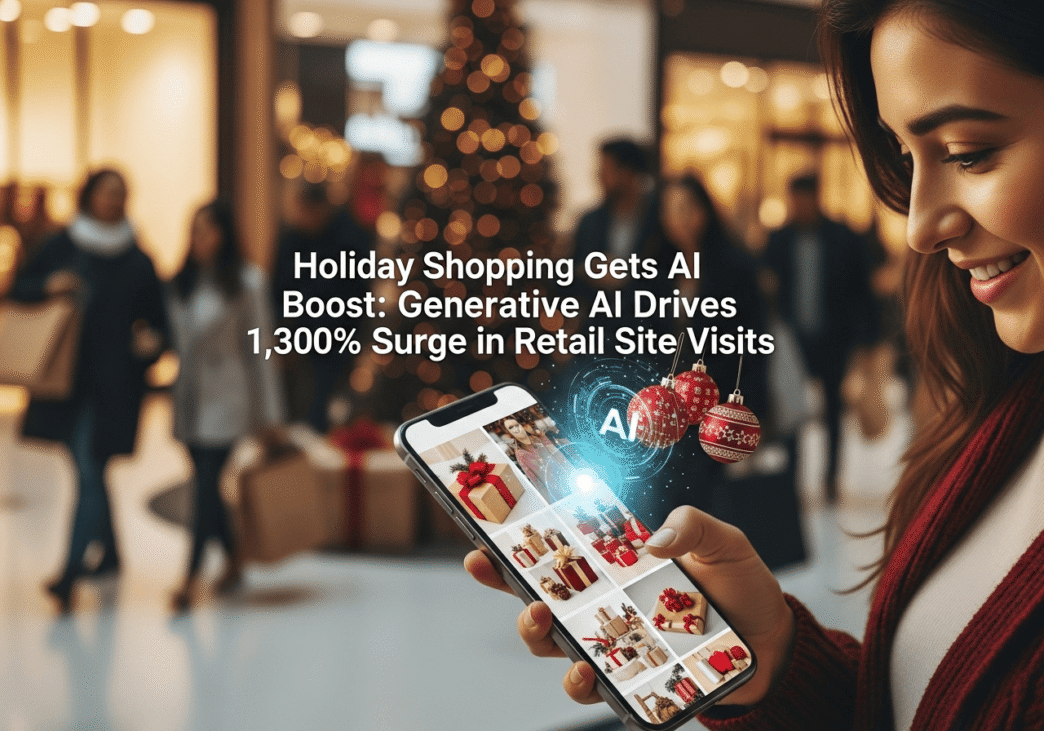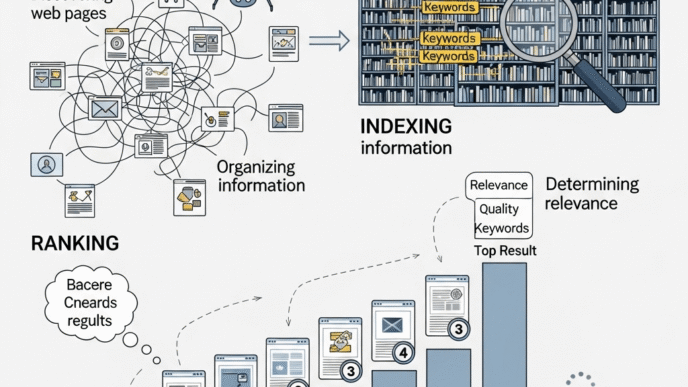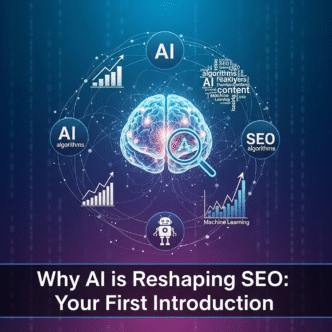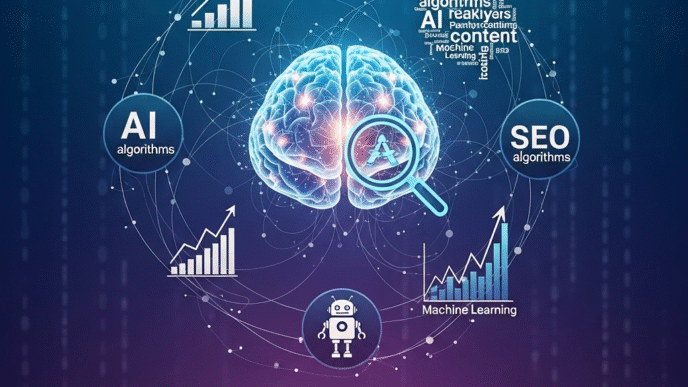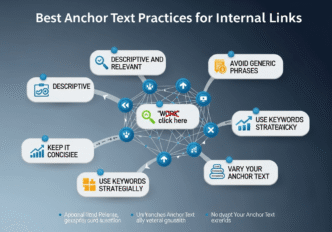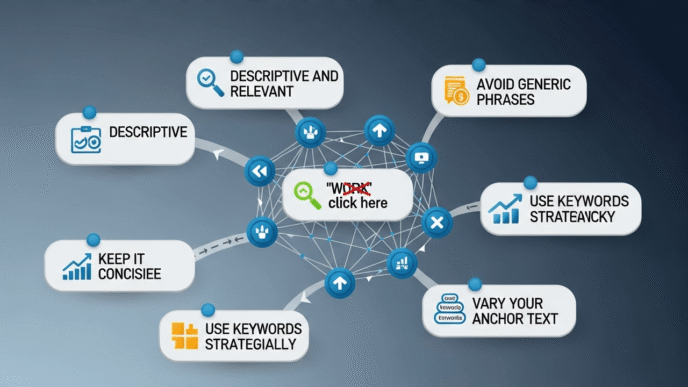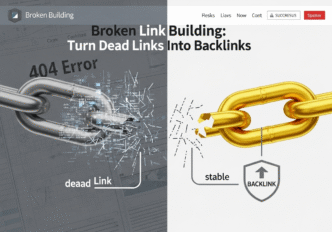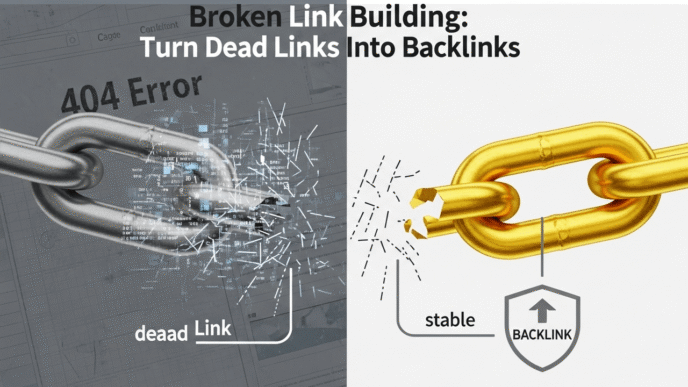Executive Summary
Bottom Line Up Front: The 2024 holiday shopping season marked a watershed moment for AI-driven commerce, with generative AI traffic to U.S. retail sites surging 1,300% year-over-year and reaching an unprecedented 1,950% spike on Cyber Monday alone. This explosive growth represents the first material impact of AI on holiday retail, fundamentally reshaping consumer shopping behaviors and forcing retailers to reconsider their digital engagement strategies.
Key Findings:
- Holiday AI traffic surge of 1,300% YoY (Nov 1 – Dec 31, 2024) vs. 2023
- Cyber Monday achieved 1,950% YoY increase in AI-driven visits
- AI traffic doubled every two months throughout 2024, continuing into 2025
- 39% of U.S. consumers used generative AI for online shopping during holidays
- Desktop dominates AI shopping at 86% vs. 34% for overall e-commerce
Table of Contents
Toggle
Market Context & Significance
The Holiday AI Breakthrough
The 2024 holiday season represents the first time generative AI meaningfully impacted retail traffic patterns. Between Nov. 1 and Dec. 31, 2024, traffic from generative AI sources increased by 1,300 percent compared to the year prior (generative AI traffic was up 1,950 percent YoY on Cyber Monday). This surge occurred against the backdrop of record holiday spending, with consumers spending $241.4 billion online during the 2024 holidays, up 8.7% from 2023.
Scale and Persistence of Growth
The holiday surge wasn’t an isolated phenomenon. The trend has persisted beyond the holiday season. In February 2025, traffic from generative AI sources increased by 1,200 percent compared to July 2024. This shows the shift in consumer behaviors over a seven-month period. Adobe’s analysis, covering over 1 trillion visits to U.S. retail sites, 100 million SKUs and 18 product categories, provides unprecedented visibility into this transformation.
Consumer Adoption Acceleration
The data reveals rapid mainstream adoption: In Adobe’s survey of 5,000 U.S. consumers, 39 percent have used generative AI for online shopping, with 53 percent planning to do so this year. This represents a significant behavioral shift, with 72% relying on AI as their primary tool for researching products and brands.
Consumer Behavior Analysis
Usage Patterns and Preferences
Primary Use Cases for AI Shopping:
- Get product recommendations (47%), Find deals (43%), Ideate for gifts (35%), Generate shopping lists (33%)
- 20% of respondents turn to generative AI to find the best deals, followed by quickly finding specific items online (19%) and getting brand recommendations (15%)
Device Preference Patterns: Traffic from generative AI sources is predominantly coming through desktop devices, at 86 percent share compared to mobile (data from Nov. 2024 through Feb. 2025), with consumers seemingly finding it easier to have a back-and-forth conversation on a laptop or desktop computer. This is in stark contrast to overall e-commerce activity, where desktop share-of-visits came in at just 34 percent during the same time period.
Demographic Breakdown
Generational Adoption Patterns:
- Millennials are at the forefront of AI-driven shopping — with 46% adoption and an additional 12% expecting to use by the end of 2025. Higher-income Millennials — those earning $70,000 or more — are the primary adopters, with over 50% engagement in AI-assisted shopping
- Baby Boomers had been skeptical of generative AI and remain the generation with the lowest usage, they are quickly coming around. They have demonstrated rapid adoption growth (up 63% from September 2024 to February 2025)
Comparative Market Performance Analysis
AI Traffic Growth vs. Traditional Channels: While AI traffic surged 1,300% during holidays, this growth occurred from a minimal base. By February 2025 these visits had a 23% lower bounce rate than all other traffic. These visits generate 12% more page views and last 41% longer than non-AI traffic, suggesting quality over quantity.
Conversion Performance Comparison:
| Metric | AI Traffic | Traditional Traffic | Improvement Trend |
|---|---|---|---|
| July 2024 | 43% lower conversion | Baseline | Starting point |
| February 2025 | 9% lower conversion | Baseline | 77% improvement |
| Engagement | 23% lower bounce rate | Baseline | Superior performance |
| Session Depth | 12% more page views | Baseline | Superior performance |
Category Performance Variations: Across e-commerce categories tracked by Adobe, conversion rates from generative AI traffic are highest in electronics and jewelry — and lowest in the apparel, home goods and grocery category.
Cross-Industry Impact Comparison:
| Industry | AI Traffic Growth | Expert Assessment | Strategic Priority |
|---|---|---|---|
| Retail | 1,300% holiday surge | Transformational | Immediate investment |
| Travel | 1,700% YoY growth | Highly beneficial | Rapid adoption |
| Financial Services | 1,200% YoY growth | Cautious optimism | Measured integration |
| Healthcare | Emerging adoption | Early exploration | Future opportunity |
Conversion Performance & Category Analysis
Conversion Rate Evolution
The conversion gap between AI and traditional traffic is rapidly narrowing: While visits from AI are still less likely to result in orders than other traffic, the gap has decreased rapidly. In July 2024, AI traffic was 43% less likely to convert than non-AI traffic. By February 2025, that gap had closed to just 9%.
Category-Specific Performance
High-Converting Categories: Across e-commerce categories tracked by Adobe, conversion rates from generative AI traffic are highest in electronics and jewelry — and lowest in the apparel, home goods and grocery category. This indicates that for products such as televisions, consumers are leaning on AI to narrow options based on individual preferences (screen size, resolution, price), which creates a higher likelihood of direct purchase.
Product Research Intensity: The data suggests 34% of consumers report using AI assistants for product research before searching online for the best deals, it’s likely that AI is still influencing conversions that occur later through traditional search or direct visits.
Technology Platform Landscape
Market Share and Growth
Chatbot Market Expansion: The global chatbot market size was valued at USD 7.76 billion in 2024 and is projected to reach USD 27.29 billion by 2030, growing at a CAGR of 23.3% from 2025 to 2030.
Retail Sector Dominance: The retail and e-commerce segment dominated the market in 2024, with chatbots enhancing shopping experiences by providing personalized recommendations and assisting with order tracking.
Enterprise Adoption Metrics
Business Implementation:
- Nearly 90% of retail companies either actively use AI in their operations or are assessing AI projects. Another 87% say AI has had a positive impact on revenue, and 94% have seen it reduce operating costs
- Since Cyber Monday 2024, retailers have increased their use of generative AI and chatbot agents by 23%. And those that used these technologies for customer service during the holiday season saw nearly double the engagement growth compared to those without these capabilities (38% versus 21%)
Cross-Industry Impact Analysis
Travel & Hospitality Transformation
In February 2025, traffic to U.S. travel, leisure and hospitality sites (including hotels) from generative AI sources increased by 1,700 percent compared to July 2024. In Adobe’s survey, 29 percent of the consumers surveyed have used generative AI for travel-related tasks, with 84 percent of those individuals saying it improved their experience.
Travel Use Cases: The top use cases among AI users include general research (per 54 percent of respondents), travel inspiration (43 percent), local food recommendations (43 percent), transportation planning (41 percent), itinerary creation (37 percent), budget management (31 percent) and packing assistance (20 percent).
Financial Services Adoption
In February 2025, traffic to U.S. banking sites from generative AI sources increased by 1,200 percent compared to July 2024. In Adobe’s survey, 27 percent of those surveyed have used generative AI for banking and financial needs.
Financial AI Applications: The top use cases among AI users include getting recommendations for checking and savings accounts (42 percent), asking for explainers on investment strategies and terminology (40 percent), creating a personalized budget (39 percent) and understanding the tax implications of financial decisions (35 percent).
Competitive Landscape & Market Dynamics
Platform Integration Developments
Shopify-ChatGPT Integration: Recent code discoveries suggest ChatGPT will connect directly with Shopify’s checkout, allowing users to find and buy products within a chat interface. This means a shopper could ask an AI assistant for the “perfect gift” and purchase it on the spot, without ever visiting a traditional website.
Enterprise Solution Growth: 34% of Amazon sellers are using AI the most for writing and optimizing listings. Another 14% say they use the technology for creating marketing and social media content. 7% of Amazon sellers even use Artificial Intelligence for Keyword research and improve SEO.
Market Valuation and Projections
AI E-commerce Market Size: The valuation of the global AI-enabled eCommerce market is $8.65 billion as of 2025. This market is further expected to reach $22.60 billion by 2032, driven by a compound annual growth rate of 14.60% from 2024 to 2032.
Future Adoption Predictions: 33% of ecommerce enterprises will include agentic AI by 2028. Today less than 1% do so. Around 70% of consumers said they would use AI agents to purchase flights, and 65% would use them to book hotels and resorts.
Expert Opinion Analysis & Market Perspectives
The Optimist Camp: AI as Transformational Force
Salesforce Leadership – Aggressive Growth Projections: Caila Schwartz, Director of Consumer Insights and Strategy for Salesforce, represents the most bullish perspective on AI’s retail impact:
“AI is on track to influence upward of $200 billion in holiday sales for the full holiday season, a 12% increase YoY. Businesses leveraging generative AI and agents for customer service during the holiday season saw nearly double the engagement growth compared to those without these capabilities (38% vs. 21%).”
Salesforce’s data suggests AI’s influence extends far beyond traffic metrics to actual sales impact, with their research showing AI influenced 19% of Cyber Week orders, accounting for $61 billion in global sales.
Adobe Research Team – Data-Driven Validation: Vivek Pandya, lead analyst at Adobe Digital Insights, provides empirical backing for the transformation narrative:
“The 2024 holiday season showed that e-commerce is being reshaped by a consumer who now prefers to transact on smaller screens and lean on generative AI-powered services to shop more efficiently.”
Adobe’s position emphasizes the consumer-driven nature of this shift, with their comprehensive tracking of over 1 trillion website visits providing unparalleled visibility into behavioral changes.
The Pragmatic Camp: Measured Optimism with Cautions
Forrester Research – Balanced Technology Integration: Sucharita Kodali, VP Principal Analyst at Forrester, offers a more measured perspective on retail technology adoption:
“As retailers brace for a challenging 2025, technology will play a crucial role in offsetting the impact of waning consumer demand. Factors such as higher wages, lower purchasing power, and increased competition from Chinese merchants like Temu are forcing retailers globally to invest in and explore innovative tech solutions.”
Forrester’s analysis suggests AI adoption is driven more by competitive necessity than revolutionary opportunity, with their 2025 retail predictions emphasizing technology as a defensive strategy rather than a growth accelerator.
Gartner Analysts – Enterprise Readiness Reality Check: Gartner’s technology analysts provide sobering context on AI implementation challenges:
“By 2025, 39% of worldwide organizations will be at the experimentation stage of Gartner’s AI adoption curve, and 14% will be at the expansion stage. Despite the enormous potential business value of AI, it isn’t going to materialize spontaneously.”
This perspective highlights the gap between AI traffic surge and actual enterprise capability to capitalize on the opportunity.
The Skeptical Camp: Early Stage Technology Assessment
VML Commerce Experts – Technology Maturity Concerns: John Batistich from VML provides a critical assessment of current AI capabilities:
“While AI chatbots surged in popularity, the technology is crude compared to what’s coming. AI-driven virtual agents will quickly take over. In the next 12 months, conversational AI and customer contact will be completely transformed.”
This view suggests current AI shopping tools represent early-stage technology that will require significant evolution before reaching full potential.
Retail Industry Practitioners – Implementation Reality: Komninos Chatzipapas, founder of HeraHaven AI, offers ground-level insights:
“In our business, we’ve seen increased traffic coming from ChatGPT in the last couple of weeks. We’re able to measure this because when it links to your site, it adds a ‘ChatGPT’ UTM source parameter. From my personal observations, this seems to be loosely correlated with how well a website ranks on Bing for keywords related to the user’s query.”
This perspective emphasizes the current limitations and dependency on traditional SEO performance for AI visibility.
Comparative Analysis: Conflicting Market Interpretations
Volume vs. Value Debate:
- High-Volume Advocates (Adobe/Salesforce): Focus on dramatic percentage increases and aggregate dollar impact
- Quality Advocates (Forrester/Gartner): Emphasize sustainable adoption and enterprise readiness
- Skeptics (Industry Practitioners): Highlight technical limitations and dependency on existing infrastructure
Timeline Disagreements:
- Immediate Impact (Salesforce): AI already driving $200B+ in sales influence
- Medium-term Evolution (Forrester): 2025 as a foundational year for technology integration
- Long-term Transformation (Gartner): Mainstream adoption still 2-3 years away
Market Maturity Assessments:
| Perspective | Current State | 2025 Outlook | Key Focus |
|---|---|---|---|
| Salesforce | Revolutionary impact | Exponential growth | Sales influence metrics |
| Adobe | Consumer-led transformation | Sustained adoption | Behavioral analytics |
| Forrester | Necessary evolution | Competitive requirement | Technology integration |
| Gartner | Early experimentation | Foundational development | Enterprise readiness |
Strategic Implications of Expert Disagreement
For Retail Leaders: The expert disagreement suggests a bifurcated strategy approach:
- Follow Salesforce/Adobe Model: Aggressive AI investment based on immediate ROI potential
- Follow Forrester/Gartner Model: Measured technology integration with focus on sustainable adoption
- Hybrid Approach: Rapid experimentation with careful measurement and gradual scaling
Risk Assessment Matrix:
High Investment Risk (Salesforce Model):
- Upside: First-mover advantage in emerging channel
- Downside: Over-investment in immature technology
- Best For: Large retailers with significant technology budgets
Conservative Adoption Risk (Gartner Model):
- Upside: Resource preservation and sustainable growth
- Downside: Missing competitive advantages
- Best For: Mid-market retailers with limited technology resources
The Consensus View: Despite disagreements on scope and timeline, all experts agree on several critical points:
- AI’s impact on retail is permanent and growing
- Consumer comfort with AI shopping is increasing rapidly
- Technology integration requires careful planning and execution
- Success depends on combining AI capabilities with human expertise
Strategic Business Implications
Immediate Operational Impacts
Cost Efficiency Gains: Data from IBM found that conversational AI cuts cost-per-contact by 23.5% and lifts revenue 4% on average. Additionally, HubSpot’s 2024 State of Customer Service & CX report found that 77% of service teams using AI are getting excellent results. Almost all (92%) say it improves their response time and improves satisfaction scores (86%).
Revenue Enhancement: McKinsey estimates this type of generative AI could unlock up to $310 billion in additional value for the retail industry, largely through customer-service automation and personalized selling.
Long-term Market Transformation
Checkout Revolution: Gen AI search engine Perplexity recently signed a deal with PayPal to handle transactions inside its platform. Recent reports say OpenAI is working with partners including Shopify on checkout technology, indicating a fundamental shift toward AI-native commerce experiences.
Revenue Model Evolution: When a gen AI like ChatGPT becomes the “new homepage” of commerce, it doesn’t need to sell products directly. “It just needs to own the watch time, then monetize via paid placements, affiliate links, and product recommendations, just like Amazon does internally”.
Risk Assessment & Challenges
Technical and Operational Challenges
Conversion Optimization: Despite engagement improvements, traffic spurred by AI was 9% less likely to result in a sale than other sources of traffic, but that number is down from July 2024, when it stood at 43%. “The narrowing gap shows that consumers are also increasingly comfortable completing a transaction directly after an AI-powered chat experience”.
Data Privacy Concerns: 44% of CEOs said that data security and privacy were the biggest challenges in using AI-based solutions in their companies, 53% of managers and employees shared this concern.
Market Fragmentation Risks
Platform Dependency: The emergence of multiple AI platforms creates new dependencies and potential fragmentation. RetAIlers must optimize for various AI assistants rather than a single search interface, increasing complexity and resource requirements.
Future Outlook & Predictions
Growth Trajectory Projections
Market Expansion: The AI chatbots market is expected to reach $22.6 billion by 2032, at a CAGR of 27.8% from 2025 to 2032, with the global conversational AI market forecast to reach $41.39 billion by 2030.
Industry Transformation Timeline:
- 2025-2026: Mainstream adoption phase with 50%+ consumer familiarity
- 2027-2028: 25% of companies will have chatbots as their primary customer service tool by 2027
- 2029+: 80% of common customer queries will be solved by Agentic AI without any human intervention by 2029
Technological Evolution
Multimodal Integration: 40% of Generative AI solutions will be multimodal by 2027, which means they will have the potential to understand not only text but also images, audio, and video clips.
Agentic AI Development: Agentic AI will lead the customer service channel by 2029, providing operational savings of up to 30%.
Strategic Recommendations
Immediate Actions (0-6 months)
AI Traffic Monitoring Implementation
- Deploy comprehensive analytics to track AI-driven traffic sources
- Establish baseline metrics for AI conversion performance
- Monitor competitor AI visibility and engagement
Content Optimization for AI Discovery
- Restructure product information for AI consumption
- Implement structured data and clear product specifications
- Develop AI-friendly FAQ and product comparison content
Desktop Experience Enhancement
- Optimize desktop shopping experiences for AI users
- Implement conversational interfaces on primary product pages
- Ensure seamless AI-to-purchase pathways
Medium-term Strategy (6-18 months)
Platform Integration Planning
- Evaluate ChatGPT, Perplexity, and other AI platform partnerships
- Develop API strategies for AI assistant integration
- Plan for direct checkout capabilities within AI interfaces
Customer Service AI Enhancement
- Deploy advanced chatbots for holiday season preparation
- Integrate AI assistants with inventory and customer data
- Develop proactive customer engagement strategies
Cross-Channel Optimization
- Align AI strategies with traditional marketing channels
- Develop attribution models for AI-influenced conversions
- Create integrated customer journey mapping
Long-term Positioning (18+ months)
AI-Native Commerce Development
- Build capabilities for conversational commerce
- Develop AI-optimized product catalogs and recommendation engines
- Create seamless omnichannel AI experiences
Market Leadership Establishment
- Invest in proprietary AI technologies and partnerships
- Develop industry-specific AI solutions
- Build competitive moats through AI-driven customer insights
Conclusion
The 2024 holiday shopping season’s 1,300% surge in AI-driven traffic represents more than a statistical anomaly—it signals the emergence of AI as a fundamental commerce channel. The data reveals a consumer base rapidly adopting AI for shopping research, product discovery, and purchase decisions, with engagement metrics that often exceed traditional channels.
For retailers, this transformation presents both unprecedented opportunities and strategic imperatives. The companies that recognize AI traffic as a permanent fixture of the commerce landscape and invest accordingly will capture disproportionate market share in the emerging AI-native economy.
The convergence of high engagement rates, improving conversion performance, and accelerating consumer adoption suggests that AI-driven commerce is moving from experimental phase to essential infrastructure. The question for retailers is not whether to embrace this transformation, but how quickly they can adapt their strategies to capture the full potential of the AI shopping revolution.
The holiday season of 2024 will be remembered as the moment when AI shopping moved from possibility to reality—and the companies that acted on this insight will define the next decade of retail commerce.
Report compiled from Adobe Analytics data covering over 1 trillion website visits, consumer surveys of 5,000+ U.S. respondents, and comprehensive industry analysis. Data encompasses November 2024 through March 2025 with historical comparisons to 2023-2024 baseline periods.

